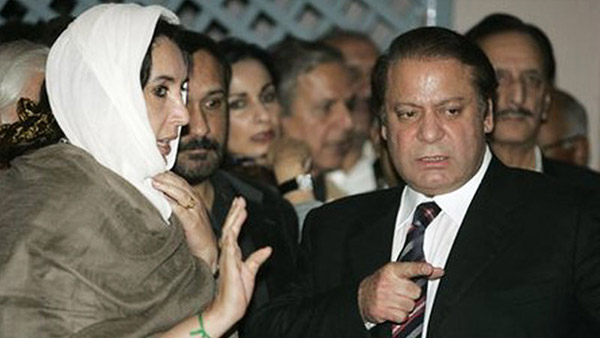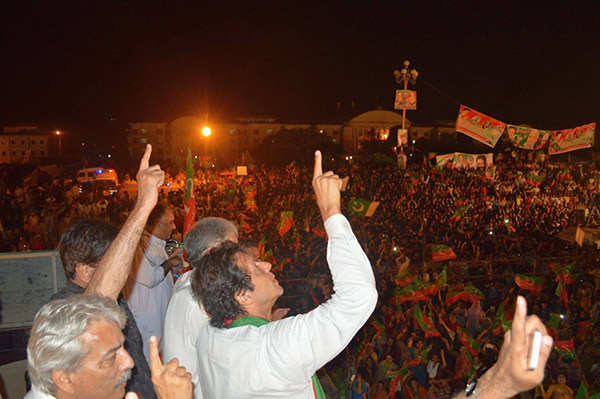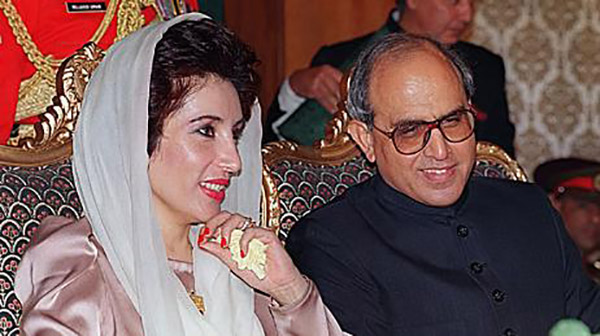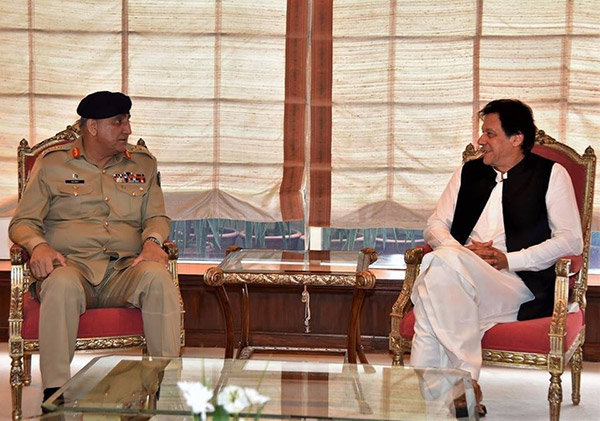
Omer Azhar in this article argues that the political landscape in Pakistan is gearing up for another change, and this time it could be a presidential system, but he believes that like every other time, this intervention too is doomed to fail.
If you want to understand the structure of Pakistan’s political system, look no further than 2007. Few know this but the then American ambassador, Bradley Hunt claimed in private meetings to multiple journalists that the Pakistan People’s Party will form the next government. He felt it was the most educated guess but delving deeper provides the rationale. A little earlier in the period from 2004-2007, Benazir Bhutto had travelled to the UK and gained glad tidings of key members in the UK government and security establishment, one of which was the Ex UK national security advisor Mark Lyall Grant who worked hard to make Charter of Democracy possible. Change was in the air as a strong UK and US lobby vouched for Benazir Bhutto and won over key figures in the Pakistani national security establishment for her return.

I like to call this political system/structure centred upon a ‘game’, a game played by the powerful political machinery (Sharifs, Zardaris, Tareens), the security establishment and international powers. It is at the converging interests of these parties where a party most often comes to power.
Though that is not true in cases where the most powerful player has the veto power. And the rules of this game are fluid and happen almost all the time behind the scenes. Take for example when Musharraf left for Qatar after his meeting with the-then Chief Justice Iftikhar Chaudry.

This incredibly famed meeting is considered to be a critical turning point in Musharraf’s dictatorial regime as a sitting Chief Judge was told to resign. However, he held his ground because signals from the makers and breakers of the system, the dealmakers had told the Chief Judge to stay put.
He soon became the symbol of a popular revolt which laid ground for civil society activism. The pressures and burdens of a dictatorship had made the system explode in favour of a return of civilian leadership. The security establishment viewed them as key to Pakistan’s progression with the ultimate decision making authority remaining with the latter. Musharraf was no longer needed in the equation to provide stability.
The Guardian states it as the end of the ‘Mush and Bush’ era in the war on terror. However, that project failed when Nawaz Sharif came back to power. But only as early as 2014, Nawaz Sharif’s government was conspired against. MNA Tahir Iqbal as early as 2015 argued that signals for next elections appeared different.

And here we are: the rules of the game are the same as in the 90s. The king’s party has all the backing and every inch of the state is trying to make PTI succeed. But has this project failed too?
Rising inflation, a balance of payment crisis and rising unemployment can be pinned on the previous governments but there is a point when the sitting government must take upon the mantle and blame for ups and downs. They continue to shy away from the burden by using accountability as a smokescreen. Where does that leave the game of politics in Pakistan? The project of bringing back civilian leaders failed, working with Nawaz Sharif failed, and the project of a long sustained dictatorship didn’t work out in the 2000s.
A clue to what is coming next is the downfall of the 18th amendment and re-emergence of the Presidential system. Yes, the same system of governance which gives one man enough power to send packing an entire Parliament: The 58(2)(B) was used to oust several elected governments in the 90s.

Even if there is no 58(2)(B) provision in the constitution this time around, controlling one person and making him bend to the whims and will of the dealmakers is easier than controlling a system built upon Prime Ministerial elections, General elections and so on.
Discourse and national conversation are always crucial pieces to the puzzle. On one hand, the foundations of a centrist national security state are firmer than ever whereas on the other, a sitting governor and several media personnel are debating the idea of whether a presidential system of governance is suitable for Pakistan. Even the sitting Prime Minister, with all the backing of the powerful players, has refused to rule out a return to Presidential form of government.

While the country debates on whether Presidential system of governance is better, let it just be stated that the projects which come about via intervention and inorganic elements are doomed to fail. They lack the will, leadership skills and political grit to lead a country battling in crisis.
The history of installed regimes reveals they are doomed for failure. Pakistan’s history is evidence and there is no doubt that the Naya Pakistan experiment is headed in a similar direction.
If you want to understand the structure of Pakistan’s political system, look no further than 2007. Few know this but the then American ambassador, Bradley Hunt claimed in private meetings to multiple journalists that the Pakistan People’s Party will form the next government. He felt it was the most educated guess but delving deeper provides the rationale. A little earlier in the period from 2004-2007, Benazir Bhutto had travelled to the UK and gained glad tidings of key members in the UK government and security establishment, one of which was the Ex UK national security advisor Mark Lyall Grant who worked hard to make Charter of Democracy possible. Change was in the air as a strong UK and US lobby vouched for Benazir Bhutto and won over key figures in the Pakistani national security establishment for her return.

I like to call this political system/structure centred upon a ‘game’, a game played by the powerful political machinery (Sharifs, Zardaris, Tareens), the security establishment and international powers. It is at the converging interests of these parties where a party most often comes to power.
Though that is not true in cases where the most powerful player has the veto power. And the rules of this game are fluid and happen almost all the time behind the scenes. Take for example when Musharraf left for Qatar after his meeting with the-then Chief Justice Iftikhar Chaudry.

This incredibly famed meeting is considered to be a critical turning point in Musharraf’s dictatorial regime as a sitting Chief Judge was told to resign. However, he held his ground because signals from the makers and breakers of the system, the dealmakers had told the Chief Judge to stay put.
He soon became the symbol of a popular revolt which laid ground for civil society activism. The pressures and burdens of a dictatorship had made the system explode in favour of a return of civilian leadership. The security establishment viewed them as key to Pakistan’s progression with the ultimate decision making authority remaining with the latter. Musharraf was no longer needed in the equation to provide stability.
The Guardian states it as the end of the ‘Mush and Bush’ era in the war on terror. However, that project failed when Nawaz Sharif came back to power. But only as early as 2014, Nawaz Sharif’s government was conspired against. MNA Tahir Iqbal as early as 2015 argued that signals for next elections appeared different.

And here we are: the rules of the game are the same as in the 90s. The king’s party has all the backing and every inch of the state is trying to make PTI succeed. But has this project failed too?
Rising inflation, a balance of payment crisis and rising unemployment can be pinned on the previous governments but there is a point when the sitting government must take upon the mantle and blame for ups and downs. They continue to shy away from the burden by using accountability as a smokescreen. Where does that leave the game of politics in Pakistan? The project of bringing back civilian leaders failed, working with Nawaz Sharif failed, and the project of a long sustained dictatorship didn’t work out in the 2000s.
A clue to what is coming next is the downfall of the 18th amendment and re-emergence of the Presidential system. Yes, the same system of governance which gives one man enough power to send packing an entire Parliament: The 58(2)(B) was used to oust several elected governments in the 90s.

Even if there is no 58(2)(B) provision in the constitution this time around, controlling one person and making him bend to the whims and will of the dealmakers is easier than controlling a system built upon Prime Ministerial elections, General elections and so on.
Discourse and national conversation are always crucial pieces to the puzzle. On one hand, the foundations of a centrist national security state are firmer than ever whereas on the other, a sitting governor and several media personnel are debating the idea of whether a presidential system of governance is suitable for Pakistan. Even the sitting Prime Minister, with all the backing of the powerful players, has refused to rule out a return to Presidential form of government.

While the country debates on whether Presidential system of governance is better, let it just be stated that the projects which come about via intervention and inorganic elements are doomed to fail. They lack the will, leadership skills and political grit to lead a country battling in crisis.
The history of installed regimes reveals they are doomed for failure. Pakistan’s history is evidence and there is no doubt that the Naya Pakistan experiment is headed in a similar direction.
